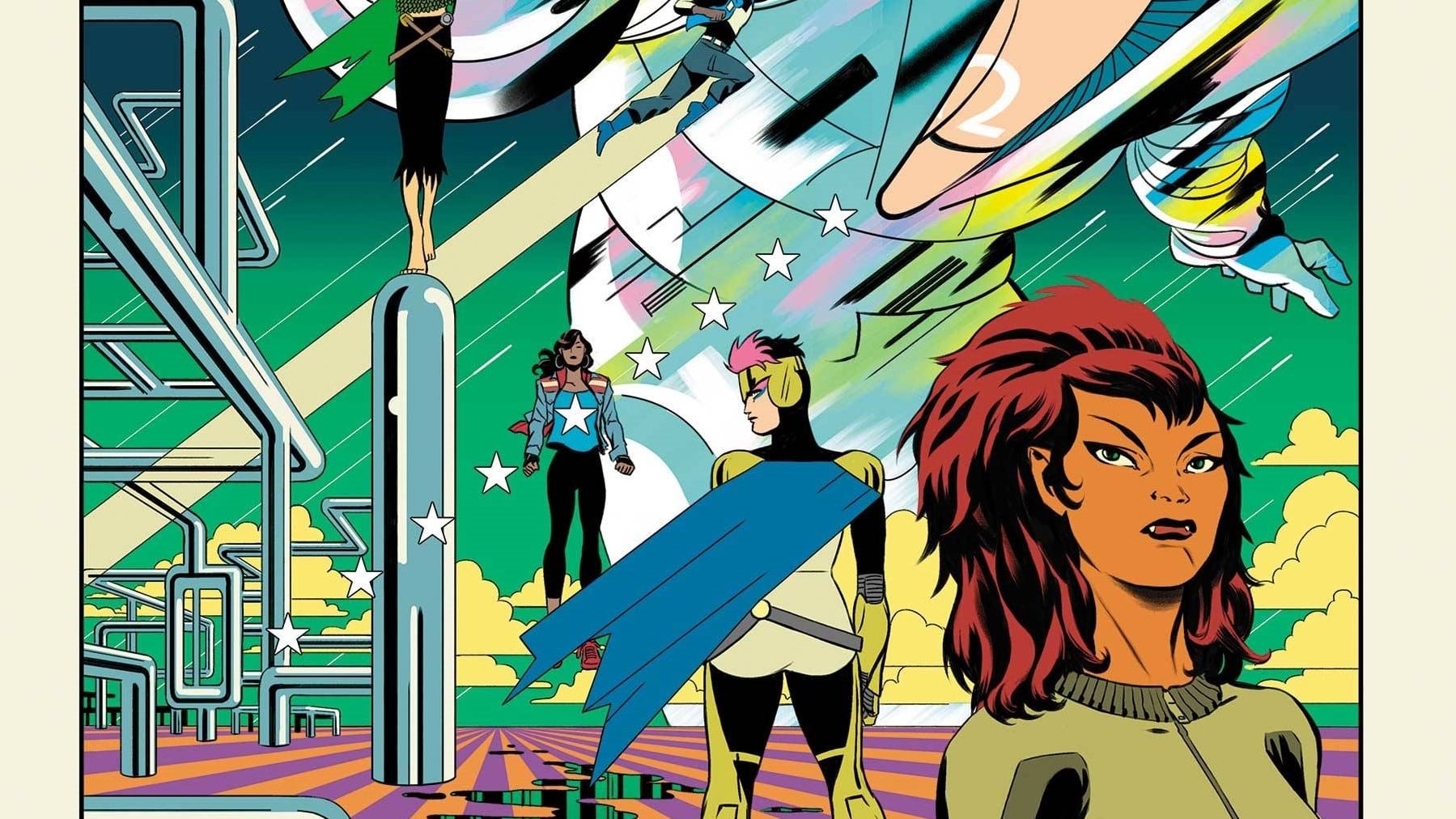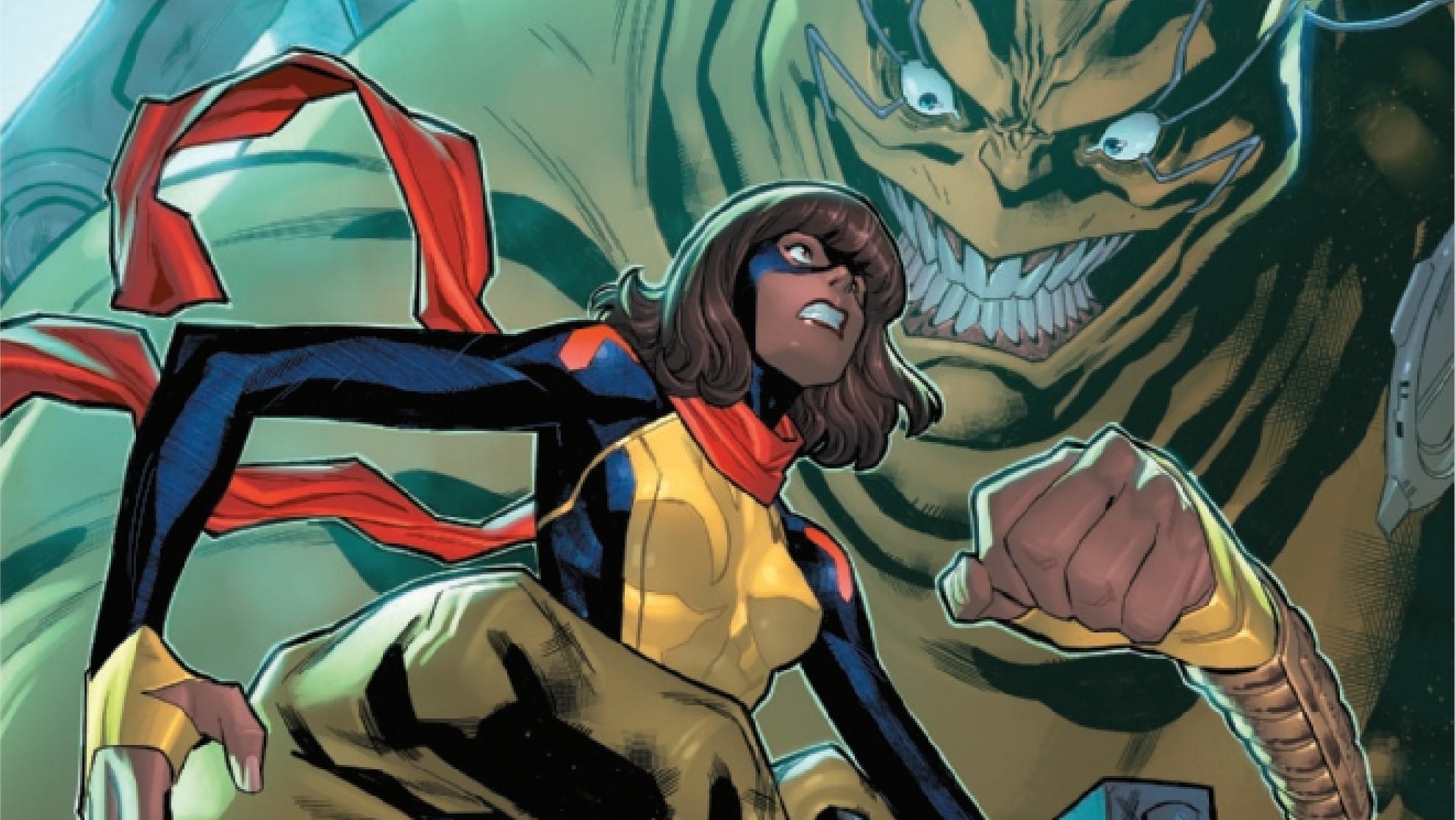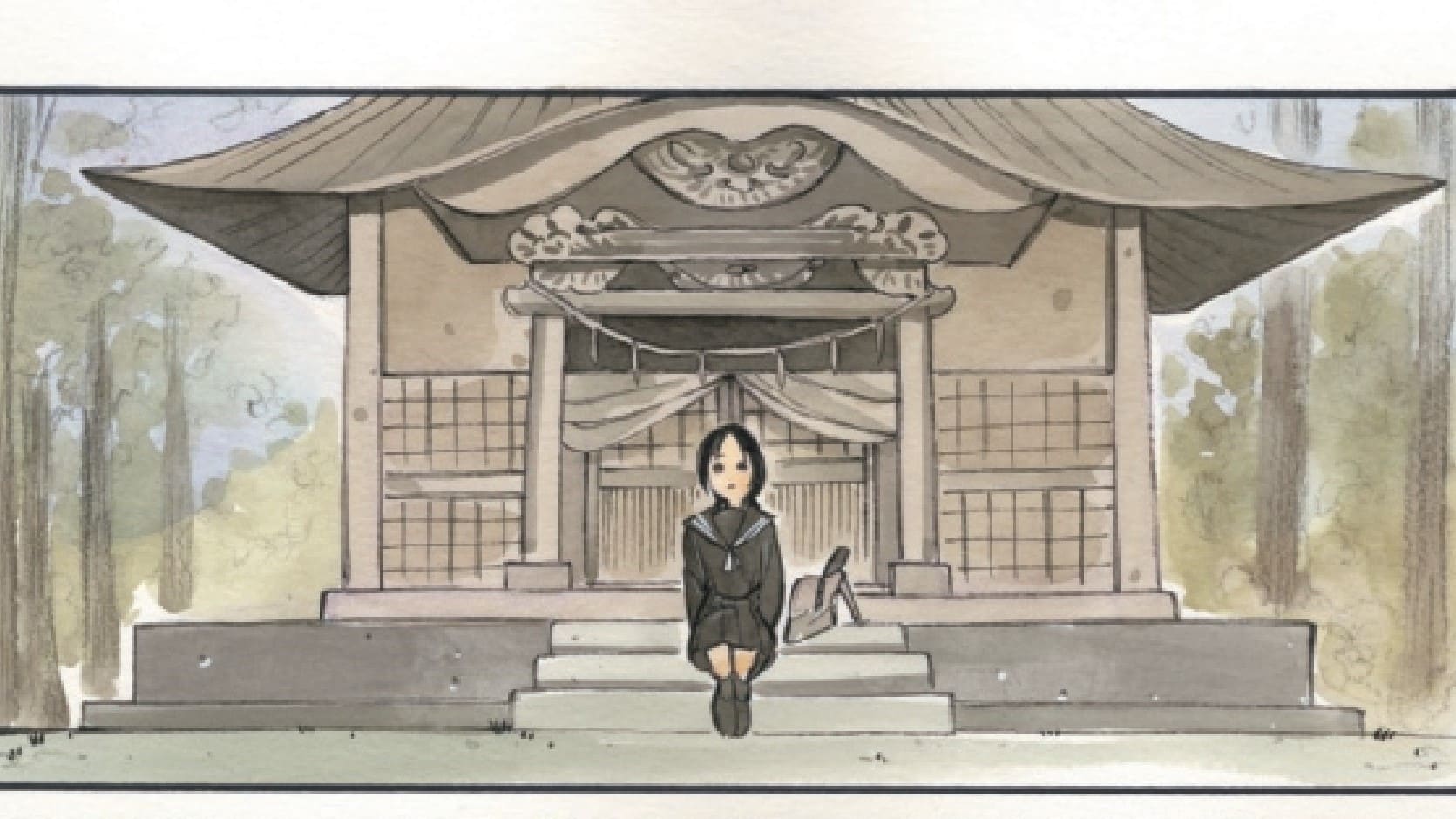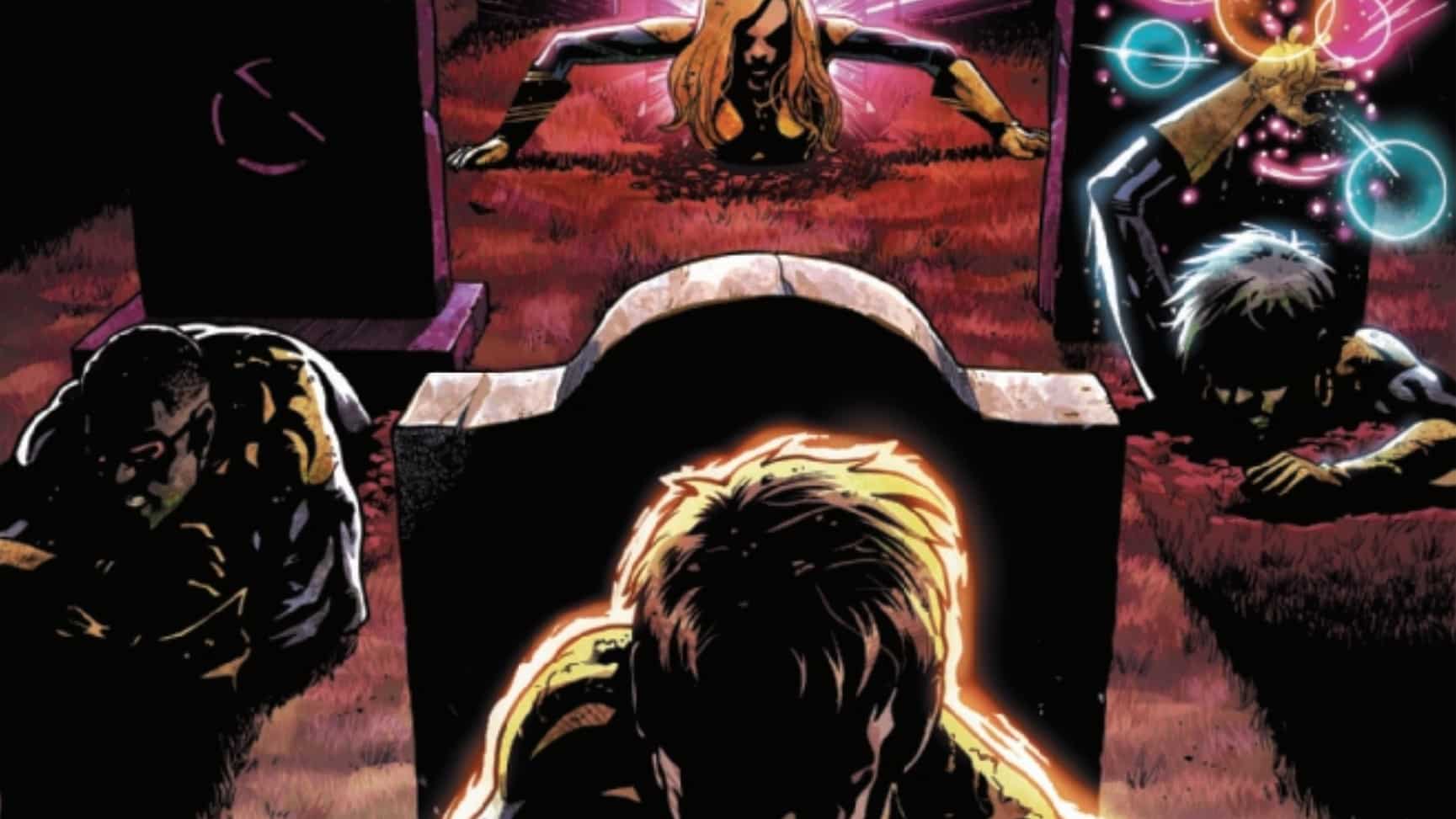As our fearless DEFENDERS continue their epic journey into THE BEYOND, the fearsome fivesome meets THE OMEGA COUNCIL and learns the SECRETS OF CREATION and possibly gains a new non-teammate in Defenders Beyond #2! As told by Al Ewing and Javier Rodríguez, with letters by Joe Caramagna.
Mark Turetsky: Well, Karen! It looks like another month of wild, psychedelic adventures and punch-em-ups in the spaces beyond space and time.
Karen Charm: I love metaphysics, I love Celestials, and I love the art of comics – this issue has it all. Ewing and Rodríguez continue to thrill me with this trip across the Marvel Universe’s cosmic prehistory. The endless rows of metallic tubes surrounding us are making me slightly claustrophobic, so we ought to hurry it along.
Tubular

Karen: This issue is titled “Yesod,” which is the next sephirot above Malkuth on the Tree of Life. Instead of Dr. Strange’s face in a crystal ball and a scary anglerfish, we have the towering presence of the Beyonder invoking the first line of Genesis. Immediately on the first page, we are steeped in religiosity. Any special insights on Yesod, Mark?
Mark: Yesod is the foundation upon which the world is built. It sits directly above Malkuth. It receives divine radiance from above and is the channel through which it reaches the world, like rain watering crops below. We see Yesod on the second page, in the first panel. It’s framed by the hands making a form (I’m not quite sure what form it is) in the center of the panel, about ¾ of the way to the top of the panel, flanked by Hod (glory) and Netzach (eternity) above it. You can see the divine power coming down in a bright line from Yesod.
The Beyonder’s creation story also reflects the one found in the Bereshit (Genesis) in a few interesting ways: first, there’s reference to “our creators” and “their creator.” The opening verse of Bereshit refers to God as “Elohim.” If you know anything about Hebrew, you’ll note that “Elohim” is a plural word, and literally means “Gods.” It also doesn’t refer to multiple gods in the Jewish tradition, but rather the one and only god, the god of the Jewish people. If you’re at all confused by that, you’re not alone.
Also, the Creation is something that happens twice in Bereshit. God creates the world in seven days, with each day doing something special (dividing the light from the darkness, dividing the water below from the water above, etc), and then God does it again, but with a bigger focus on the creation of people. This might be reflected in the Beyonder’s telling of the creation of the first and second cosmos. The current thinking behind the literary reason for the retelling in Bereshit is that they come from two distinct textual sources, and that the whole of the book is compiled from separate and distinct texts. So, imagine instead of having the four gospels of the New Testament, instead they were edited down to just one gospel, pulling from all the others. Just one continuity but with different writers with different goals in telling the story. Sounds kinda like comics.
The rebellion of Celestials may be a reflection of the story of Adam and Eve and the exile from Eden, but more likely it’s to do with the War in Heaven, where Satan and some other angels break bad and are cast out. I mostly know about that from Paradise Lost and its companion comic, Mike Carey’s Lucifer.
Finally, the notion that the “creators who had no collective name” are akin to the angels who worshipped God during the creation of the world (as described in the Job, not Bereshit). As Ewing writes it, “They worshipped their creator. What else was there to do?”
Karen: Ah, I love what you’re seeing in that first panel – you’re completely correct whereas I was only seeing the “eyes in the sky” as the face of the First Firmament (as seen in our beloved Ultimates). This is just one example of the multivalent and sublime compositions Rodríguez is giving us in these first few pages. It’s nothing new for him, as he’s already detailed the History of the Marvel Universe before, but here it’s like he’s able to really just focus in on the Beginning part and perfect every shape and angle. The following panel of the rebellious Celestials is breathtaking. Not for nothing, the rainbow-colored outcasts smashing the status quo puts a smile on my face. Very Pleasantville, very “pride was a riot” haha.
Mark: I wrote extensively in my and Stephanie’s review of Defenders #4 about using cyan, magenta, and yellow as the primary colors of the fundamentals of the Marvel universe, and here we get a repeat of that motif, with the Celestial firing a Kirby-nonsense color cannon blowing the universe apart. The first bands are cyan, yellow, magenta, and then composite colors, followed by wild mixes of color. It’s great stuff, and puts me in mind of “that page” from We3, where the flat, 2-D comic page is exploded outwards through a heightened sense over and above the “reality” of the page.
Karen: The second cosmos is literally built out of the debris and shrapnel of the first. While it’s explicitly the first Multiverse, it also kind of looks like Battleworld in another jaw-dropping panel. Fitting this is where the Beyonders come into the story. Whereas the Celestials migrate from the First to the Second, and ultimately into the Third and so on, the Omega Beings they created to tend to chaos of multiversity get stranded Beyond, outside all that is known. Which is where our Defenders now stand face-to-face with a quintet of Ivory Kings, aka Beyonders (first seen in Matt Fraction and Jamie McKelvie’s Defenders, I believe).
Taiaa, our favorite Sciencer Supreme, is thrilled to be experiencing something she’s only ever theorized, but Tigra knows better. She knows that guy…
Mark: Yeah, that one in the fancy armor with the dark hair is the Beyonder. He gives us one of those recap pages that were so common in the pre-modern comics era. And while Tigra wasn’t involved in Secret Wars (the 1984 one), she was in Secret Wars II. I particularly love that the Beyonder compares himself in Secret Wars to a baby whose only view of the world is commercials for action figures, which Secret Wars famously was.
Karen: He’s saying what we’ve all been thinking! I like how stupid Ewing writes the Beyonder because… he just is. Anyway, all of the Beyond-splaining does yield a clue of what this whole book is about. Am I reading that word correctly? DOMINION?! I’ve heard of those! (Why is this comic the best?)
It would appear the ultimate threat the Defenders are facing is a Dominion, an indefinable cosmic intelligence indistinguishable from “godlike” that exists outside of linear time. The way the Omega Council describes it lines up pretty neatly with what Hickman gave us in Powers of X and I couldn’t be more thrilled. It’s also worth noting that Dominions and Phoenixes are invoked as opposing forces in that X-Men book. Very interesting indeed!
A superhero comic can only endure so much talking, however, before fists must fly. The Defenders don’t like how cavalierly the Beyonders cop to wiping out the Seventh Cosmos (during another Hickman Joint), and Blue Marvel calculates the not-team’s odds on getting out of their flies-among-giants predicament.
Mark: It’s the superhero comic story reasserting itself. And that story demands fight-em-ups (just picture J Jonah Jameson demanding you-know-what)!
The Stories We Tell Ourselves

Karen: As a sensitive yet neurotypical person, I’ve spent a decent amount of time in the self-help section of life. I’ve had more than a few people recommend Brene Brown to me, and one of the core messages she talks about is the power of narrative. Particularly the way in which humans can typecast themselves with a limited story of who we are. “I could never get a promotion because I’m not the kind of person who gets recognized like that,” for example. At best it’s a way to limit your life to a safe known quantity, at worst it keeps you in a self-perpetuating loop of suffering. It’s a lens through which to look at behavior patterns I’ve found useful. It’s also what makes Loki, as the Goddess of Stories, such a formidable Defender, as we see here. The Omega Council of Beyonders are so big and powerful, yet their nature as “linear beings” makes them utterly susceptible to Loki’s narrative abilities. We see her literally box in one Beyonder with comics panels, a perfectly direct application of the medium’s magic.
Mark: When your opponents are concepts, having a (not-a-) team member be the concept of story really helps. It also helps to have a cosmic-level power like Blue Marvel, and a former cosmic-level hero who likes punching smug gods in the face with a convenient power-up. And with some really choice color palettes on the part of Rodríguez. The panels America pushes The Beyonder through and the backgrounds, you can really see why Rodríguez started out as a sought-after colorist on pages like this. The pairings he makes between the foreground panels and the background are just eye-poppingly gorgeous, along with the “SMACK!” he’s drawn in.
Karen: The sound effects in this issue are very “flying V electric guitar” and I love that.
It’s fascinating to see how the Omegas/Beyonders respond, by lashing out in retaliation. The story here is that any slight against you must be returned with violence, which, to be fair, is also the conclusion that the superheroes come to first. You’ll also notice that shortly after this, Rodríguez stops using the Engine Room tubing as panel borders and falls back to more standard rectangular frames. The shift doesn’t happen when the Beyonder falls prey to narrative, but when the Defenders do as well. They may be Beyond, but there’re still very much within the confines of the content this publisher produces. As the antagonist bellows, we are here to “watch the story play out” in the way we’ve come to expect.
Out of the Frying Pan and into the Fire and Life Incarnate

Karen: This issue is so fun that I almost missed the note to feel sad when my dear Taiaa is struck down. She doesn’t die immediately, but she’s in horrible shape. Meanwhile, America and the Beyonder We Know are knocking the definition out of each other, evenly matched. Blue Marvel finds a way out through the Engine Room’s energy source and the Defenders high-tail it out of there with the Beyonder We Know close behind. The remaining Omega Council chooses to resist the “narrative forces” by staying behind in one of my favorite jokes in the whole issue.
Mark: They’re drawing power from “a higher dimension,” which would be Tiferet, which is Splendor. It sits right in the middle of the Tree of Life, and as such connects to all of the other sefirot, save Malkuth below. It corresponds to the Sun, and is the force that balances Gevurah (“Strength”) and Chesed (God’s boundless love, compassion). It’s the balancing force. What is a sacrifice for one person may become a new endeavor, a rebirth for another, so everything is in balance. Speaking of sacrifice and rebirth, how is Taiia doing?
Karen: I’ve read enough X-Men comics that I grimace whenever anyone replays the Phoenix speech, but Al Ewing does it well here (as I’ve come to expect from him and anything he attempts). Having it be Taiaa who’s still slapping scare quotes wherever possible makes it genuinely funny. It doesn’t hurt that Rodríguez’s new costume for her is totally amazing.
I think what is exciting me most is the prospect of Ewing getting to finally map out the White Hot Room, which was teased most recently in S.W.O.R.D. It seems we’re taking a detour before we get to the first cosmos, but I couldn’t ask for a better destination. The Phoenix has been done to death at this point, can Al Ewing bring new life to it?
Mark: For me, I think the cool part is that the previous Defenders miniseries gave magical definitions to the four offset printing colors, cyan (water, love, The Cup), magenta (air, misfortune, the sword), yellow (Earthly wisdom, physical force, the coin) and black (the binding force, the Arcana). The white page beneath was “the fires of learning […] the Wand.” So the white page itself is The White Hot Room. When you look at a comics page, the images are literally coming out of the fires of Creation (well, from the perspective of the characters on the page, at least). It also makes me think of the space Loki ended up in at the end of Agent of Asgard, or the white space in the gutters between panel-prisons in Gillen and McKelvie’s Young Avengers. Ooh, or what about what that might mean for Gwenpool?
Marvelous Musings
- I do not have the desire or energy to engage in an MCU debate, but I will say that every step toward this kind of cosmic nonsense those movies make the happier I am. (KC)
- I love Nezarr the Calculator so much. (KC)
Also, why not check out our colleague Zach’s interview with Ewing touching on all things cosmic and creative from last year?







